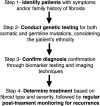Genetic and biomarker approaches to uterine fibroids: toward precision medicine
- PMID: 40330123
- PMCID: PMC12052703
- DOI: 10.3389/fgwh.2025.1581823
Genetic and biomarker approaches to uterine fibroids: toward precision medicine
Abstract
Uterine fibroids (UFs) are the most common benign tumors of the female reproductive system, affecting 70%-80% of women by age 50. Early detection is challenging due to the absence of initial symptoms, and diagnosis primarily relies on ultrasound and magnetic resonance imaging (MRI). However, biomarker-driven approaches could enable earlier and more precise detection. This review explores emerging biomarkers and genetic factors in fibroid pathogenesis. Potential biomarkers, including PLP1, FOS, versican, LDH, and IGF-1, show promise for diagnosis and recurrence prediction. Genetic studies have identified key mutations in MED12, FH, HMGA2, and COL4A5-COL4A6, alongside genome-wide association studies (GWAS) that highlight fibroid risk loci. Interestingly, biomarkers may also be mutation-type specific, suggesting potential for more precise molecular classification. Gene therapy offers an innovative treatment approach but the genetic landscape of fibroids remains underexplored, limiting advancements in research and funding. Integrating biomarker-based diagnostics and genetic profiling could transform fibroid detection and management, reducing reliance on invasive procedures. This review highlights the urgent need for improved diagnostic tools, prognostic markers, and targeted therapies for uterine fibroids.
Keywords: biomarkers; early diagnosis; genetic predisposition; leiomyoma; precision medicine; quality of life; uterine fibroid; women's health.
© 2025 Mukherjee.
Conflict of interest statement
The authors declare that the research was conducted in the absence of any commercial or financial relationships that could be construed as a potential conflict of interest.
Figures

Similar articles
-
Prevalence and clinical significance of co-existing mutations in MED12 and FH in uterine fibroids of Australian women.Front Reprod Health. 2023 Apr 11;5:1081092. doi: 10.3389/frph.2023.1081092. eCollection 2023. Front Reprod Health. 2023. PMID: 37113812 Free PMC article.
-
Uterine fibroids at single-cell resolution: unveiling cellular heterogeneity to improve understanding of pathogenesis and guide future therapies.Am J Obstet Gynecol. 2025 Apr;232(4S):S124-S134. doi: 10.1016/j.ajog.2024.08.037. Am J Obstet Gynecol. 2025. PMID: 40253076 Review.
-
Uterine Fibroids (Leiomyomata) and Heavy Menstrual Bleeding.Front Reprod Health. 2022 Mar 4;4:818243. doi: 10.3389/frph.2022.818243. eCollection 2022. Front Reprod Health. 2022. PMID: 36303616 Free PMC article. Review.
-
The management of uterine fibroids in women with otherwise unexplained infertility.J Obstet Gynaecol Can. 2015 Mar;37(3):277-285. doi: 10.1016/S1701-2163(15)30318-2. J Obstet Gynaecol Can. 2015. PMID: 26001875
-
Safety and efficacy of the selective progesterone receptor modulator asoprisnil for heavy menstrual bleeding with uterine fibroids: pooled analysis of two 12-month, placebo-controlled, randomized trials.Hum Reprod. 2019 Apr 1;34(4):623-634. doi: 10.1093/humrep/dez007. Hum Reprod. 2019. PMID: 30865281 Free PMC article. Clinical Trial.
References
-
- Upreti R, Dray M, Elston MS. Uterine fibroid causing hyperprolactinemia and paradoxical prolactin rise with dopamine agonist: case report and systematic review. SN Compr Clin Med. (2020) 2(4):464–7. 10.1007/s42399-020-00248-6 - DOI
-
- ucsfhealth.org. Fibroids (2025). Available at: https://www.ucsfhealth.org/conditions/fibroids (Accessed February 22, 2025).
Publication types
LinkOut - more resources
Full Text Sources
Miscellaneous

